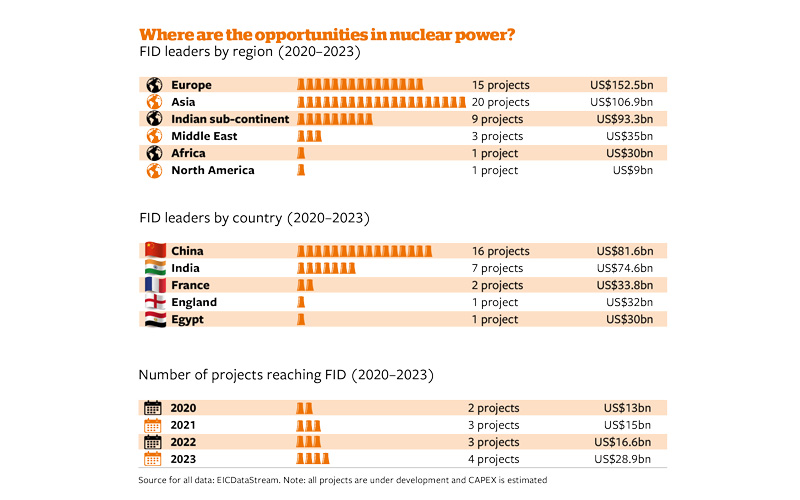Global nuclear opportunities on the rise
As the case for nuclear power’s impact on energy security becomes more compelling, countries are increasingly recognising the crucial role of nuclear energy in reaching net zero. Fernando Vieira at EIC looks at the global opportunities on offer

During the last 12 years, there has been a substantial worldwide reassessment of nuclear energy. Following the Fukushima Daiichi nuclear accident, safety concerns cast doubt on nuclear technology. Despite the advancement of cutting-edge technologies aiming to address safety queries, Conventional Nuclear Power Plants (CNPPs) of Gen III and III+ continue to serve a crucial role in mitigating long-term emissions. They remain a reliable, localised energy source, especially amid the ongoing Russia-Ukraine war.
In the US, the Westinghouse AP1000 (PWR) model, a Gen III+ nuclear reactor certified by the US Nuclear Regulatory Commission (NRC), began its commercial operations at Vogtle Power Plant in mid-2023. This serves as a compelling illustration of how CNPP technology continues to play a crucial role in the ongoing efforts to decarbonise global economic growth.
CNPPs around the world
The EICDataStream database documents expansion and refurbishment projects around the world, presenting prospects for operation and maintenance (O&M) services, as well as opportunities for engineering, procurement and construction companies. Even nuclear plants initially slated for decommissioning have undergone reassessment amid the prevailing geopolitical circumstances.
Europe, North America and Asia have witnessed a resurgence in conventional nuclear reactor CAPEX after initial scepticism and project stagnation. However, the nature and stage of proposed projects vary across each region.
Europe
In France, EDF has spearheaded US$50bn of financing since 2016 for upgrades and O&M work for a fleet of conventional nuclear power reactors. Nearly 50 reactors have been or are undergoing refurbishment to meet new safety standards and extend operational lifespans beyond 40 years.
France’s expansion plans, including the US$19bn project to add two new Gen III+ reactors at the Penly Nuclear Power Plant by 2035 using the EPR2 model (each with a 1,650MW capacity) in partnership with Framatome, show advancements. Penly and Gravelines Nuclear Power Plants stand out, with an anticipated financial investment decision (FID) and startup estimated for mid-2025 and the mid-2030s respectively. The new reactor model EPR2 is still expected to be employed at the Bugey Nuclear Power Plant, although the project currently lacks a specified FID expectation.

EDF plays a strategic role in the UK, developing the US$32bn Hinkley Point C and US$28bn Sizewell Nuclear Power Plant projects. Both projects will use two EPR reactors (each of 1,600 MW), with Hinkley having secured FID in 2016 and expected commercial operation by 2028. Sizewell’s FID is anticipated by late 2024, targeting startup in the mid-2030s.
Poland is a significant player in Eastern Europe’s nuclear sector. The government’s US$14bn funding for the Poland Nuclear Power Plant projects aims to operate seven to eight Gen III+ PWR reactors, expecting to add 6–9GW of nuclear capacity by 2043. While lacking an FID expectation, government approval is in place, and front-end engineering design work is ongoing.
North America
In North America, particularly the US, there is an emphasis on modernisation and upgrades rather than phasing out traditional reactors. The successful completion of the Vogtle expansion in Georgia, involving two new Westinghouse AP1000 reactors, is a clear example of this approach. Many projects are dedicated to extending the operational lifecycle of existing assets, exemplified by efforts at the Byron and Braidwood Nuclear Power Plants in Illinois and the Surry Nuclear Power Plant in Virginia.
Since 2013, Canada’s focus has been refurbishing four CANDU reactors at the Darlington Plant, with the aim of extending the plant’s life by another 30 years. The ongoing US$9bn O&M contract with GE Power and BWX is expected to conclude by late 2026.
Asia
While China and India boast 38 nuclear projects, the majority are developed and operated by nuclear state-owned companies. These projects largely collaborate with the local supply chain. India, however, presents a promising market for American and French companies following recent discussions between Biden, Macron and President Modi to bolster bilateral nuclear cooperation for energy deployment purposes.
Five major projects targeting FID in 2024/2025
Gravelines Nuclear Power Plant Reactors 7 & 8
- Value: US$18.8bn
- Country: France
- Operator: EDF Group
- Start-up year: 2038
Integral Molten Salt Reactor
- Value: US$0.7bn
- Country: Canada
- Operator: Terrestrial Energy
- Start-up year: 2028
Penly Nuclear Power Plant Reactors 3 & 4
- Value: US$18.8bn
- Country: France
- Operator: EDF Group
- Start-up year: 2035
Sizewell C Nuclear Power Plant
- Value: US$28.1bn
- Country: England
- Operator: EDF Energy
- Start-up year: 2034
Kozloduy Nuclear Power Plant Unit 5 & 6 Upgrade and Unit 7 & 8 New Build
- Value: US$7.7bn
- Country: Bulgaria
- Operator: Bulgarian Energy Holding
- Start-up year: 2033
By Fernando Vieira, Energy Consultant, EIC.
Interested in exploring global nuclear opportunities?
Inform your decision-making with the latest contracting activity and market research from EIC. To discuss your needs, email Aadam Sufi at Aadam.Sufi@the-eic.com
Image credit | Shutterstock | iStock






Follow us
Advertise
Free e-Newsletter